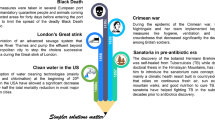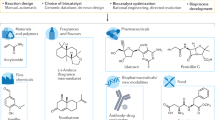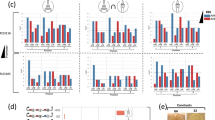Abstract
Biotechnology has established itself as one of the most promising, exciting sectors in our economy: its talent base is among the 'best and the brightest'; it receives large amounts of government funding; it is relatively immune to poor economic cycles; and it has products that are increasingly in demand due to gaps in big pharma pipelines. However, there are many challenges to differentiating the sizzle from the steak. This article will discuss how to determine intrinsic value creation in the biotechnology industry over the long haul.
This is a preview of subscription content, access via your institution
Access options
Subscribe to this journal
Receive 12 print issues and online access
$209.00 per year
only $17.42 per issue
Buy this article
- Purchase on Springer Link
- Instant access to full article PDF
Prices may be subject to local taxes which are calculated during checkout



Similar content being viewed by others
References
Cooke, R. Dr Folkman's War: Angiogenesis and the Struggle to Defeat Cancer 80–81 (Random House, New York, 2001).
Leung, D. W. et al. Vascular endothelial growth factor is a secreted angiogenic mitogen. Science 246, 1306–1309 (1989).
Benson, A. B. et al. Bevacizumab (anti-VEGF) plus FOLFOX4 in previously treated advanced colorectal cancer (advCRC): an interim toxicity analysis of the Eastern Cooperative Oncology Group (ECOG) study E3200. Proc. Am. Soc. Clin. Oncol. A975 (2003).
Horrobin, D. Realism in drug discovery — could Casandra be right? Nature Biotechnol. 19, 1099–1100 (2001).
Rees, J. Complex disease the new clinical sciences. Science 296, 698–701 (2002).
Lehman Brothers and McKinsey & Company Analyst Report. The Fruit of Genomics: Drug Pipelines Face Ingestion Until the New Biology Ripens (January 2001).
Roberts, T. G. The phase 3 trial in the era of targeted therapy: unraveling the 'go or no go' decision. J. Clin. Oncol. 21, 3683–3695 (2003).
Rosenberg, S. A. et al. Observations on the systemic administration of autologous lymphokine-activated killer cells and recombinant interleukin-2 to patients with metastatic cancer. N. Engl. J. Med. 313, 1485–1492 (1985).
Rosenberg, S. A. et al. Prospective randomized trial of high dose interleukin-2 alone or in conjunction with lymphokine-activated killer cells for the treatment of patients with advanced cancer. J. Natl Cancer Inst. 85, 622–632 (1993).
Isis Pharmeceuticals. Isis Pharmaceuticals and Eli Lilly and Company announce results of Affinitak Phase III clinical trial in non-small cell lung cancer. Press release (17 March 2003).
Lynch, T. Cancer medicine and hematology. Harvard Medical School 'Lung Cancer' Course. (September 21,26 2003).
Angell, M. Evaluating the health risks of breast implants: The interplay of medical science, the law, and public opinion. N. Engl. J. Med. 334, 1513–1518 (1996).
Opinion: FDA to Cancer Patients: Drop Dead (September 2002) and Topic of Cancer (April 2003). Wall Street Journal.
Cohen, S. N., Chang, A. C., Boyer, H. W. & Helling, R. B. Construction of biologically functional bacterial plasmids in vitro. Proc. Natl Acad. Sci. USA 70, 3240–3244 (1973).
Belikova, A. M., Zarytova, V. F. & Grineva, N. I. Synthesis of ribonucleosides and diribonucleoside phosphates containing 2-chloroethylamine and nitrogen mustard residues. Tetrahedron Lett. 37, 3557–3562 (1967).
Stephenson, M. L. & Zamecnik, P. C. Inhibition of Rous sarcoma viral RNA translation by a specific oligodeoxyribonucleotide. Proc. Natl Acad. Sci. USA 75, 285–288 (1978).
Stipp, D. Biotech's billion dollar breakthrough. Fortune 147, 96–98 (2003).
Frantz, S. Studies reveal potential pitfalls of RNAi. Nature Rev. Drug Discov. 2, 763–764 (2003).
Paull, R. et al. Investing in nanotechnology. Nature Biotechnol. 21, 1144–1147 (October 2003).
Ribas, Antoni et al. Current developments in cancer vaccines and cellular immunotherapy. J. Clin. Oncol. 2, 2415–2432 (2003).
Genentech company press release (6. 01. 03)
Persons, D. A. & Nienhuis, A. W. Gene therapy for the hemoglobin disorders. Curr. Hematol. Rep. 2, 348–355 (2003).
Williams, D. A. & Baum, C. Gene therapy — new challenges ahead. Science 302, 400–401 (2003).
Chapman, P. Update on melanoma vaccines. ASCO 199 Educational Book 126–129 (1999).
Moving beyond the genome projects. Nature Biotechnol. 14, 1234–1238 (1996).
Dove, A. Cell-based therapies go live. Nature Biotechnol. 20, 339–343 (2002).
Stadtmauer, E. et al. Conventional–dose chemotherapy compared with high–dose chemotherapy plus autologous hematopoietic stem–cell transplantation for metastatic breast cancer. Philadelphia Bone Marrow Transplant Group. N. Engl. J. Med. 342, 1069–1076 (2000).
Timmons, H. Company that cloned sheep to sell assets and shut down. New York Times (16 September 2003).
Gura, T. Antisense has growing pains. Science 270, 575 (1995).
Anderson, W. F. Human gene therapy. Nature 392, S25–S30 (1998).
Willaims, D. & Baum, C. Gene therapy — new challenges ahead. Science 302, 400–401 (2003).
Kolata, G. Hope in the lab: a cautious awe greets drugs that eradicate tumors in mice. New York Times (3 May 1998).
Bhandari, M. et al. The pharmacogenomics challenge. In Vivo (1999).
Holtzman, N. & Marteau, T. Will genetics revolutionize medicine? N. Engl. J. Med. 343, 141–144 (2000).
Boston Consulting Group. A Revolution in R&D: How Genomics and Genetics are Transforming the R&D Industry (2001).
Frantz, S. & Smith, A. New drug approvals for 2002. Nature Rev. Drug Discov. 2, 95–96 (2003).
Beyond talk. Forbes, (November 24, 2003).
Zambrowicz, B. & Sands, A. Knockouts model the 100 best-selling drugs — will they model the next 100? Nature Rev. Drug Discov. 2, 38–51 (2003).
Author information
Authors and Affiliations
Related links
Related links
DATABASES
Cancer.gov
LocusLink
Online Mendelian Inheritance in Man
FURTHER INFORMATION
Encyclopedia of Life Sciences
Rights and permissions
About this article
Cite this article
Glassman, R., Sun, A. Biotechnology: identifying advances from the hype. Nat Rev Drug Discov 3, 177–183 (2004). https://doi.org/10.1038/nrd1309
Issue Date:
DOI: https://doi.org/10.1038/nrd1309
This article is cited by
-
Social Responsibility in Stem Cell Research - Is the News All Bad?
Stem Cell Reviews and Reports (2016)
-
Is belief larger than fact: expectations, optimism and reality for translational stem cell research
BMC Medicine (2012)
-
Early dissemination of bevacizumab for advanced colorectal cancer: a prospective cohort study
BMC Cancer (2011)
-
Growth of the Asian health-care market: global implications for the pharmaceutical industry
Nature Reviews Drug Discovery (2007)
-
Vers de nouveaux tests biologiques pour prédire le potentiel métastatique d’un cancer
Bio tribune magazine (2005)



